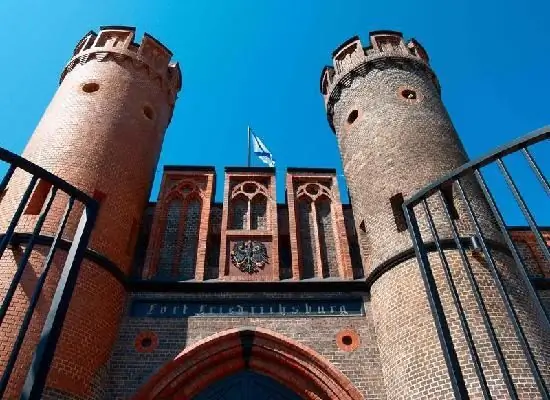- Author Harold Hamphrey [email protected].
- Public 2023-12-17 10:06.
- Last modified 2025-01-24 11:10.
Plymouth is a city in England located on the south coast of Devon. This is the largest settlement in the south-west of the country, famous for its traditions of navigation and fishing. The number of inhabitants exceeds 250,000 people. Mild climate, comfortable bay for yachts, ancient architecture attract thousands of tourists here.
Where is the city of Plymouth
Plymouth (having the administrative status of "city") is located at the junction of the historical regions of Devon and Cornwall. The estuary of the Tamar and Plym rivers forms a natural harbor protected from storms. It is no coincidence that the largest operational naval base in Europe, HMNB Devonport, is located in the vicinity.
Transport links with the city are well developed. The M5 federal highway connects Plymouth with Central England. Exeter Regional Center is 60 km away and London is 310 km away. Tourist liners and passenger ships ply along the coast. Newquay International Airport is 60 km away.

Early history
In the cavesnear Plymouth in England, traces of people who lived here in the Upper Paleolithic were found. During the Bronze Age, there was already a port here, one of the largest on the coast. Numerous artifacts collected by archaeologists testify to this.
In the famous "Geography" of the ancient Greek historian Ptolemy, the settlement of Tamari Ostia (a city in the Tamar estuary) is mentioned. It was guarded by a large fort built on the coastal promontory of Round Head and connected to the sites of Lineham Warren, Boringdon and Maristow.
Middle Ages
Until the end of the 10th century, Plympton was located upstream of the River Plym. However, at the beginning of the 11th century, the river began to quickly silt up. Merchants and fishermen were forced to build piers at the mouth. Over time, residential buildings were also moved closer to the sea.
In Old English the settlement was called Sutton, at the beginning of the 13th century it was already mentioned as Plym Mouth (“the mouth of the river Plym”). The current name of Plymouth in Britain was established in the 15th century, and was first officially mentioned in the charter of King Henry VI, dated 1440.

Renaissance
At the end of the 15th century, a quadrangular fortress was built in the Barbican area with round towers in each corner. It still adorns the coat of arms of the city. The main purpose of the fortification was to protect Sutton Harbor, which was the main base before the creation of Plymouth Dockyard.
Tensioned relations with France and Spain forced the Parliament of England to allocate funds to expand the defenses. The result is a chain of sixartillery blockhouses, a fort on St. Nicholas Island and a fortified entrance to Sutton Bay, equipped with a long chain to delay enemy ships. In the 1660s, the Royal Citadel was built in Plymouth (England), making the port virtually impregnable.

New World
During the period of great geographical discoveries, the city became one of the world's centers of navigation. It was one of the main export ports for wool. Captain, adventurer, privateer and slave trader Francis Drake brought bad (among enemies) fame to Plymouth. He became famous not only for daring pirate raids, but also led the defeat of the Invincible Armada of the Spaniards, who intended to conquer England. Moreover, from 1581 to 1593, Drake headed the city hall.
In 1620, the Pilgrim Fathers set off from Plymouth in England to explore the vast lands of North America. They founded a successful colony in the current state of Massachusetts, which became the base for numerous Mirgants. Until now, in New England (USA) they honor the memory of the founders and observe many traditions long forgotten in their homeland.
Follow-up development
Throughout the 17th century, Plymouth gradually lost its importance as a trading port. Goods made in other parts of England became too expensive to transport through the city. However, it remained the base of slave traders who transported black Africans to the plantations of South, Central and North America.
"Second wind" opened after the construction of a largeshipyard. The first dock was commissioned in 1690. Subsequent commissioned in 1727, 1762 and 1793. Many Plymouth residents have found work here. Gradually, the town of Devonport grew up around the shipyard, whose population reached 3,000 by 1733.

Pearl of the South West of England
At the end of the 18th and beginning of the 19th century, Plymouth (Great Britain), thanks to the efforts of a group of architects and builders led by John Folston, acquired its current neoclassical look. The Ateneum, the Royal Theatre, the Royal Hotel and Union Street became the pearls of architecture. Today it is one of the most romantic cities in Cornwall and Devon.
In 1768, local chemist William Cookworthy founded Plymouth Porcelain, one of the earliest porcelain makers in the British Empire. This was made possible by the discovery of special clay deposits in Cornwall. Plymouth porcelain was made using solid phase synthesis and differed from other manufacturers in a special "cold" sparkling white.
By the middle of the 19th century, the urban agglomeration of Plymouth - Stonehouse - Devonport had developed. Today it is united into a single administrative unit - the city. In order to connect the enclave settlements, in 1812 the construction of a bridge in Plymouth Sound, designed by John Rennie, began. However, numerous technical difficulties, unsteady ground and frequent storms delayed construction for many decades. The author of the project did not live to see the opening of the bridge, which took place only in 1841.
In the 1860saround Devonport a ring of Palmerston forts was built to protect the shipyard from attack from any direction. By this time, the port had regained its commercial importance. Many goods from America and Europe were imported through it, including corn, wheat, barley, sugar cane, guano, sodium nitrate, and phosphates. The end of the 19th century was marked by a technological revolution. A railway was built to Plymouth, trams, cars appeared in the city, the streets were lit with gas lamps.

Twentieth century
During the First World War, Plymouth in England was the port where troops were brought from the colonies of the British Empire. Ammunition was also made here. Despite the fact that the main elements of the Royal Navy moved to a safer place (in Scapa Flow), Devonport remained an important base for Coast Guard and escort ships.
During World War II, Devonport was the headquarters of the Western Defense Sector Command. Plymouth and the shipyards were badly damaged during the Nazi air raids. During the opening of the second front in the summer of 1944, the city played an important role as a deployment point for landing ships.
After the war, the leading English architect Patrick Abercrombie was engaged in the reconstruction of the destroyed quarters (and in total about 3,700 houses and industrial facilities were destroyed). By the way, he also developed a plan for the restoration of London. The main task was to relocate residents from densely built-up overcrowded slums to suburbs with individual low-rise buildings. Builderscoped with a difficult task. By 1963, 20,000 new houses had been built.
Many old buildings in the center were demolished, and in their place a zoned modern building with green spaces was created. A prime example of mid-20th century architecture is Plymouth's Modernist Civic Center.
The Devonport shipyard has retained its importance. In particular, they repair and refit aircraft carriers and nuclear submarines of the Royal Navy.

Plymouth Attractions
England is one of the most popular travel destinations in the world. The city is visited by tens of thousands of tourists every month. Among the most interesting objects, we note:
- Sutton area. Includes over 100 historic buildings, a harbor and the largest area of cobbled streets in the country.
- The Barbican Embankment is the sea gate of the city. One of the few old quarters that escaped destruction during the 2nd World War.
- Plymouth University, one of the largest in the UK.
- The limestone cliffs of Plymouth Hoe, currently heavily built up with coastal structures, including defensive ones.
- Smeaton Tower. This is a former lighthouse of the 18th century, and now it is an observation deck.
- There are 20 war memorials in the city. Among them, Plymouth Naval Memorial (which is an analogue of the Tomb of the Unknown Soldier) and Armada Memorial (opened in honor of the 300th anniversary of the defeat of the Spanish Armada) stand out.
- National Marine Aquarium (the deepest in the country). Hereabout 400 species of underwater inhabitants live.
- S altram Manor - George II era mansion.
- Crownhill Royal Fort, 1860s

Plymouth is a favorite destination for boaters and photographers thanks to the city's picturesque harbour.






